Physical Address
304 North Cardinal St.
Dorchester Center, MA 02124
Germ cell tumors of the ovary are presumed to derive from the pathogenic transformation of ovarian germ cells at different stages of development. The tumors that develop from these transformed germ cells are among the most unique in the human body for the simple reason that they re-create, however imperfectly, aspects of human development ( Fig. 26.1 ). Germ cell neoplasms are divided into three general categories by the most recent World Health Organization (WHO) classification: germ cell tumors, monodermal teratoma and somatic-type tumors arising from a dermoid cyst, and germ cell–sex cord stromal tumors ( Box 26.1 ). Tumors in the first category have a wide range of differentiation, including immature germ cells (dysgerminoma), early embryonic development (embryonal carcinoma, polyembryoma), extraembryonic differentiation (yolk sac tumor, nongestational choriocarcinoma), and mature and immature somatic tissues (mature and immature teratoma). The second category includes struma ovarii, ovarian carcinoid tumors, and somatic-type malignancies arising from mature teratomas (dermoid cysts). Tumors composed of a mixture of germ cells and sex cord stromal cells, which are classically represented by gonadoblastoma, make up the third category.
Dysgerminoma
Yolk sac tumor
Embryonal carcinoma
Nongestational choriocarcinoma
Mature teratoma
Immature teratoma
Struma ovarii, benign
Struma ovarii, malignant
Carcinoid
Strumal carcinoid
Mucinous carcinoid
Neuroectodermal-type tumors
Sebaceous tumors
Other rare monodermal teratomas
Carcinomas
Squamous cell carcinoma
Others
Gonadoblastoma
Germ cell–sex cord–stromal tumor, unclassified
Germ cell tumors account for 20% to 25% of all ovarian neoplasms in females and occur more frequently in females than males. The great majority of germ cell tumors in females are mature teratomas, which are benign. Only 3% to 5% of all germ cell tumors in females are malignant, of which the majority are dysgerminomas, immature teratomas, and yolk sac tumors in a pure form or as part of a mixed germ cell tumor, all occurring in young patients. Somatic-type malignant transformation in mature teratoma is rare and corresponds to an additional 1% to 2% of cases, being encountered predominantly in older patients.
In this chapter, ovarian germ cell tumors are classified into two categories. Tumors in the first category are composed exclusively of mature, adult-type tissues, which include mature teratoma, with all monodermal variants and somatic-type malignancies arising in association with them. Mature teratoma is the most common ovarian tumor and corresponds to 95% of all ovarian germ cell tumors. It is believed to arise from the transformation of benign germ cells via parthenogenesis.
The second category encompasses all germ cell tumors with embryonal, fetal, and extraembryonic differentiation. They are commonly referred to as malignant germ cell tumors or primitive germ cell tumors and are believed to derive from malignant primitive germ cells. All remaining germ cell tumors belong in this category—immature teratoma, dysgerminoma, yolk sac tumor, embryonal carcinoma, polyembryoma, and nongestational choriocarcinoma. These tumors have a low incidence, some are rather rare, and they occur predominantly in children, adolescents, and young women.
The end of the chapter discusses gonadoblastoma, which is the prototypical mixed germ cell and sex cord stromal tumor, followed by an account of the relatively newly recognized category of somatically derived germ cell tumors.
Mature teratoma is the most common ovarian tumor and corresponds to at least 40% of all ovarian tumors and 95% of all ovarian germ cell tumors. The great majority of these are cystic and therefore have traditionally denominated mature cystic teratoma in clinical practice. In the ovary, dermoid cyst is often used as a synonym for mature cystic teratoma as these lesions almost always show obvious and prominent components associated with the skin—keratin, hair, and sebaceous material. Historical records have indicate that the terms teratoid, teratomatous, and dermoid cyst of the ovary have been used interchangeably since the first descriptions from 1862 to 1872. We consider that the terms mature teratoma and mature cystic teratoma are preferable because they portray the germ cell origin of these tumors better. Furthermore, dermoid cyst is a general term that is used not only for tumors of germ cell origin, but also for unrelated processes encountered in other medical disciplines, such as neurosurgery, dermatology, otorhinolaryngology, and pediatrics. Nonetheless, dermoid cyst is likely to remain an alternative name for mature teratoma in the ovary. These neoplasms are believed to arise via parthenogenesis, in which growth and development of the egg occur without fertilization.
Mature teratomas predominate in the reproductive years, with most presenting between the ages of 20 and 50 years, with a mean in the mid-30s. They correspond to the ovarian tumors most commonly found during pregnancy.
Despite the fact that malignant germ cell tumors are commonly encountered before 20 years, mature teratoma is still the most common of the two diagnosed in this age group and is five times more likely to be diagnosed than a germ cell malignancy. Only in postmenopausal women are epithelial tumors more common than mature teratoma.
Mature teratomas are diploid, contain a normal 46,XX karyotype, and are homozygous for polymorphic markers, supporting a parthenogenetic origin from a single germ cell. Most mature teratomas show evidence of chromosomal recombination, which indicates that the lesional cells arise from meiotic oocytes or mature postmeiotic ova. Apparently, mature teratomas can originate at various stages of gametogenesis, with most resulting from meiotic errors.
Approximately 20% of patients are asymptomatic at the time of discovery. The most frequent symptom is lower abdominal pain. Acute abdominal pain is uncommon, and 5% to 10% of mature teratomas have been reported to be associated with ovarian torsion. Rupture of ovarian mature teratoma occurs in less than 3% of all cases. Peritoneal lipogranulomas and melanosis have been rarely described in association with ruptured mature teratomas.
Women with ovarian teratomas may rarely develop anti- N -methyl- d -aspartate receptor (NMDAR) encephalitis, which has been recognized as an uncommon but severe neurologic disorder, characterized by psychosis, memory loss, decreased consciousness, seizures, autonomic dysfunction, and hypoventilation. According to the largest study available, in 60% of patients affected by NMDAR encephalitis, tumors were detected following the onset of neurologic symptoms, of which 90% were teratomas; of these, approximately two-thirds were mature teratomas and one-third were immature teratomas. The median age for all patients was 23 years. The condition appears to be a sort of paraneoplastic autoimmunity and has good response to immunosuppressive therapy.
Most ovarian mature teratomas can be diagnosed by ultrasonography and are characterized by echogenic sebaceous material and calcifications. The most common ultrasound appearance is that of an echogenic tubercle, with a cystic echo. Mature teratomas often do not appear cystic on ultrasound, which may lead to the interpretation of a solid neoplasm concerning for malignancy. The diagnosis of mature teratoma is generally made without difficulty by computed tomography (CT) and magnetic resonance imaging (MRI) because both methods are highly sensitive for fat attenuation, which is diagnostic for mature teratoma in the ovary.
Approximately 10% of benign cystic teratomas are bilateral. Right-sided tumors are slightly more common than left-sided tumors. Multiple mature teratomas in a single ovary have been described in a few patients, and those were almost always also bilateral. The size ranges from 5 to 10 cm in 50% to 60% of mature teratomas, with a median diameter of 6 cm, but up to 10% may be larger than 15 cm.
The gross picture can be typical or extremely variable. The most classic appearance of a mature teratoma is that of a smooth-lined cyst containing a mixture of hair and oily brown to tan sebaceous material ( Fig. 26.2 ). However, the cyst contents may appear hemorrhagic, similar to an endometriotic cyst, or the tumor may be multicystic. A raised protuberance, designated as a Rokitansky tubercle containing adipose tissue, skin appendages, and overlying skin, is often present ( Fig. 26.3 ). This area tends to display the most tissue heterogeneity and often is the only focus at which tissues other than squamous epithelium and skin appendages are found microscopically. As a rule, the more complex the lesion, the more likely other elements will be detected. Teeth are present in a minority of these but are dramatic ( Fig. 26.4 ). A case of a giant mature teratoma has been reported that weighed 10 kg and contained more than 300 teeth.
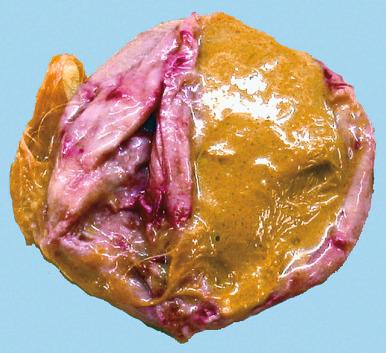

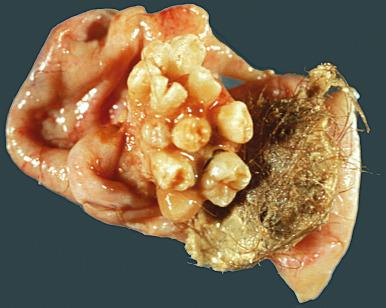
Some mature teratomas may pose questions at the time of gross examination, as exemplified by the following variants.
A rare variant of mature teratoma, with only about 25 cases reported to date, was found to have the appearance of a malformed fetus on gross examination, termed a homunculus or fetiform teratoma ( Fig. 26.5 ). The caudal portion, including lower extremities with varying degrees of limb formation, is better developed than the cephalic portion, and visceral tissues are rarely encountered. The homunculus should not have a well-developed segmented axial skeleton, which is considered to be too developed for a teratoma.
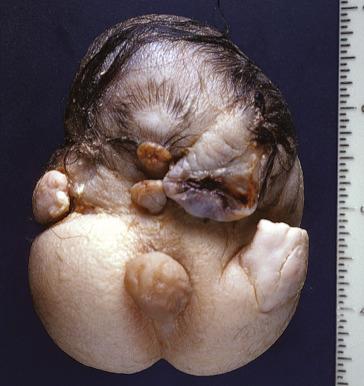
These tumors may initially be mistaken for ovarian ectopic pregnancies but are recognized by the absence of placental tissue and umbilical cord. The embryo or fetus of an ectopic pregnancy will display less mature tissues than those seen in a fetiform teratoma; these have been reported to be composed of completely mature, adult-like tissues. Another extremely rare entity that may be confused with a fetiform teratoma is termed fetus in fetu , wherein a leftover twin of the patient has been ensconced in the pelvic cavity for years. Because these are not typically in the ovary, they may be easily distinguished.
Less than 2% of mature teratomas are predominantly solid (albeit not completely solid), often showing many small cysts that contain hair, sebaceous material, and serous or mucinous fluid. These tumors may be considered suspicious for malignancy by imaging and gross examination, but contain only mature teratomatous elements microscopically. Areas of necrosis in a solid tumor are most consistent with immature teratoma and should not be seen in a mature solid teratoma. In such cases, extensive sampling should be done to search for histologic evidence of immature elements.
Most mature teratomas have characteristic imaging findings and are not submitted for intraoperative frozen section examination. Suspicious clinical or imaging findings may lead the surgeon to request a frozen section, particularly in children and postmenopausal women. Below are the principal tasks for the pathologist when grossly examining the specimen and selecting tissue for frozen or permanent sections.
Immature teratoma merits particular consideration in patients in the first and second decades of life. The median greatest diameter for immature teratoma is 18 cm, in contrast to 6 cm for mature teratoma ( Table 26.1 ). The classic appearance of a mature teratoma is that of a unilocular smooth-lined cyst with a lumen filled with oily brown to tan sebaceous material admixed with hair, while immature teratomas are typically predominantly solid containing areas that only vaguely resemble normal tissues and multiple small cysts (see later, Fig. 26.48 ). The greater the percentage of solid tumor, the higher the suspicion for immature teratoma, particularly if the solid area is not readily identifiable as skin, thyroid, cartilage, or other mature element. However, less than 2% of mature teratomas are predominantly solid, and one-fourth of immature teratomas contain a grossly visible dermoid cyst. Abundant neural tissue appears soft and fleshy and may show a yellowish to grayish encephaloid appearance. Immature neuroectodermal tissue may be found embedded in these more differentiated neural components. Areas of necrosis are suspicious, not only for immature teratoma but also for other malignant germ cell tumor components. Low-grade immature teratomas are unlikely to be identified as such on frozen section because diagnostic immature neuroectodermal tissue is focal and only detectable with thorough sampling and careful microscopic examination. The pathologist should exercise caution when choosing to be definitive about the presence of immature elements on frozen section. If an immature germ cell tumor is suspected, the surgeon may choose to proceed to full staging. The risk of contralateral ovarian involvement in immature teratoma is negligible, although a contralateral mature teratoma is present in as many as 15% of cases. The differential diagnosis of mature and immature teratoma on microscopy is presented later in this section (see “ Differential Diagnosis ”).
| Parameter | Mature Teratoma | Immature Teratoma | Somatic-Type Malignancies |
|---|---|---|---|
| Most affected age group (yr) | 20–50 | 10–520 | 40–70 |
| Mean age at diagnosis (yr) | 35 | 19 | 55 |
| Potentially elevated serum markers | None | AFP (mild), CA-125 (mild) | SCC antigen, CA-125, CA-19-9 |
| Gross appearance | Predominantly cyst | Predominantly solid | Variable |
| Laterality | 10% bilateral | Unilateral but 15% contralateral teratoma | Unilateral |
| Median tumor size | 6 | 18 | 13 |
| Immature teratomatous elements | Absent | Present | Absent |
| Malignant somatic-type elements | Absent | Absent | Present |
| Biologic behavior | Benign | Malignant | Malignant |
| Prognosis | Favorable | Favorable | Poor |
A coexisting malignancy is rare and, if encountered, is usually in a larger tumor in a postmenopausal woman (see Table 26.1 ). Most are squamous cell carcinomas, mucinous tumors, carcinoid tumors, and thyroid carcinomas. Squamous cell carcinoma that arises from a mature teratoma usually manifests as a cystic mass, with a fungating tumor or solid nodule. Although frozen section is not required to verify a hair-filled cyst with a Rokitansky tubercle, suspicious masses or lesions should be evaluated by frozen section to ensure that further staging is not necessary.
In keeping with the wide diversity of tissues that may be seen grossly, an even wider range of variation can be appreciated on histologic examination of mature teratomas, being limited only by the constraints on human tissue differentiation. Virtually any structure observed in the developing or adult human body may be encountered, as depicted in Figs. 26.6 and 26.7 . The tissues present in a mature teratoma can be categorized based on the corresponding germ layer:
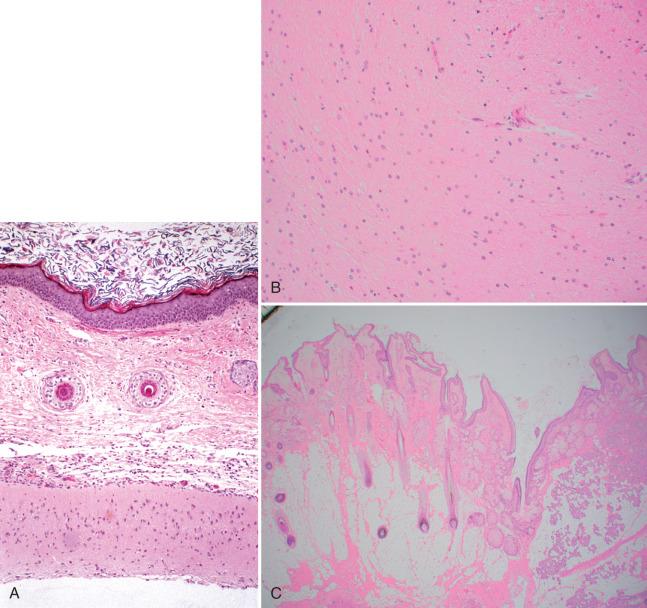
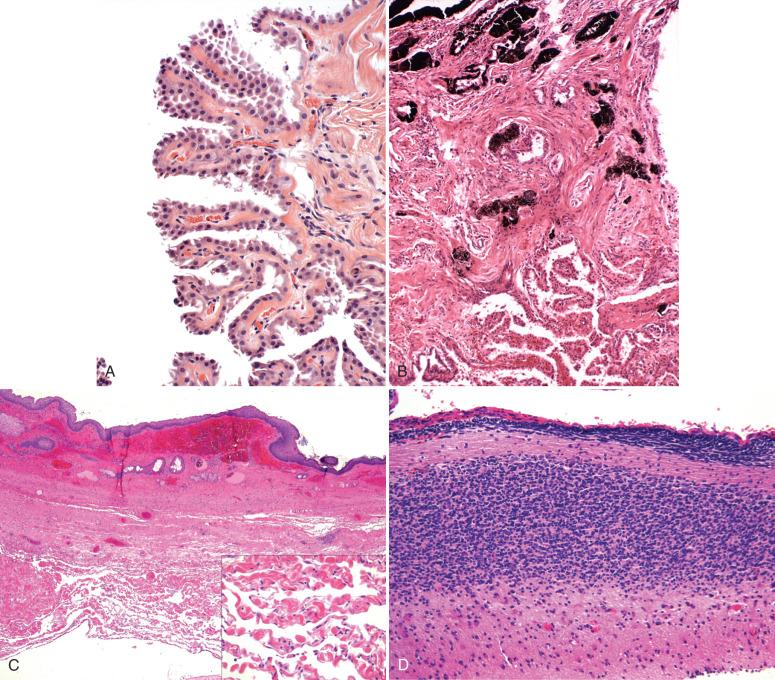
This is seen in nearly 100% of mature teratomas. It consists of epidermis, skin appendages, and neural tissue. Practically all mature teratomas contain skin. Neural tissue is seen in one-third to half of mature teratomas and has the appearance of a mature central nervous system. Glial tissue is usually abundant and contains bland astrocytes in a copious fibrillary background. Larger neuronal cells that simulate neurons with the appearance of ganglion cells can be seen focally, in a disorganized distribution; they are large and have a vesicular nuclei, prominent nucleoli, discernible basophilic cytoplasm, and dendritic processes. Pigmented retinal epithelium, nerve bundles, and choroid epithelium may be seen, although uncommon.
This is represented in 73% of mature teratomas and includes fat, cartilage, bone, and teeth. Adipose tissue is the second most frequent component of mature teratomas, found in two-thirds of cases. Cartilage is reported to be present in about 40% of mature teratomas and teeth in about 8%.
This is found in 30% of immature teratomas. The most common derivations are respiratory epithelium, seen in at least 15% of cases, and gastrointestinal epithelium, seen in about 7% of cases. Thyroid tissue was reported in 7% of cases in a large consecutive series of 305 mature teratomas from a single institution; of these, 20% were composed predominantly of thyroid tissue and were categorized as struma ovarii. See later, “ Struma Ovarii ,” for information on how to classify thyroid tissue in teratoma.
Other patterns that can cause confusion, even to experienced pathologists, are as follows.
At least three categories of neural tissue may lead the pathologist to consider the possibility of immature teratoma, which includes mature neuroepithelium, differentiating neural tissue, and minor foci of immaturity. Details on the features of these findings are presented later (see “ Differential Diagnosis ”).
Sometimes, rupture of the cyst wall in a teratoma may lead to a prominent inflammatory reaction with abundant histiocytes, not leaving much of the teratomatous tissue behind. This is a process similar to what is more frequently seen in the ovary and termed burned-out endometrioma. Histiocytic giant cells are often seen engulfing keratin ( Fig. 26.8 ). Abundant keratin debris and scattered hair follicles are clues to the diagnosis. Even a careful search may not reveal viable teratomatous cells.

These were once thought to be rare in mature teratomas but have been shown to be more frequent in a recent publication. The histologic appearance is subtle, demonstrating a network of slitlike interanastomosing channels lined with cuboidal cells arranged in dense collagen bundles.
Although mature neural tissue is a common component of teratomas, the presence of differentiated cerebellum is rare, with fewer than 15 cases reported in the literature to date. It recapitulates the fetal and adult cerebellum, with most being composed of molecular, Purkinje cell, and internal granular layers. One-third of cases also have an external granular layer; this is a progenitor cell layer that decreases after birth and totally disappears by the second postnatal year.
Those in association with a mature teratoma mimicking hemangioma have been reported; rarely, neural elements of mature and occasionally immature teratoma may show a prominent secondary vascular proliferation, which is benign but may lead to a misdiagnosis of a vascular neoplasm. It is composed of long, thin-walled, curvilinear vessels or a solid glomeruloid arrangement. The vascular nature of this proliferation can be demonstrated by the expression of vascular markers in endothelial cells, such as CD31.
Small case series have shown that abnormal neurons exhibiting binucleation or multinucleation and dysmorphic shapes, in addition to prominent lymphocytic infiltrates, are seen in teratomas resected from patients with NMDAR encephalitis.
Other tissues rarely found in mature teratomas include pituitary tissue, prostatic tissue, seminal vesicle, lactating breast tissue, and thymic tissue. These have been reported in mature teratomas of the ovary as small case series and isolated case reports.
While navigating this potentially confusing array of patterns, the pathologist has three tasks. The first is to develop a familiarity with these patterns, learning to recognize their diverse appearances. The second is to identify immature elements, and the third is to identify malignancies arising in adult-type tissues, both of which can place the patient at risk for recurrence and confer a worse prognosis.
In general, the diagnosis of mature teratoma is made histologically without difficulty, and the use of routine immunohistochemistry is not necessary. In a small proportion of cases, immunostains may be used in the setting of immature teratoma, monodermal teratomas, and somatic-type malignancies.
To rule out immature teratoma, the identification of immature neuroectodermal epithelium is done by careful examination of conventional tissue sections. The use of immunostains is not indicated. Mature and immature neural elements are positive for glial fibrillary acidic protein (GFAP), neuron specific enolase (NSE), and S-100. Neuronal cells are positive for NeuN, synaptophysin, and chromogranin. The Ki-67 proliferation index would be higher in immature mature neuroepithelium compared with mature neural tissue, which stains positively in less than 1% of cells. However, this is a surrogate marker for high mitotic and apoptotic activity in immature neuroepithelium that can be observed on hematoxylin and eosin (H&E) stain. There are only a few studies to date that have investigated the immunostaining pattern of primitive germ cell markers in immature teratoma. According to their findings, immature neuroectodermal tissue is positive for SOX2, variably positive for SALL4, and negative for NANOG. In addition, a subset of cells is positive for octamer-binding transcription factor 4 (OCT4), whereas all are negative for PAX6 and CD56 expression. Teratomatous immature and intestinal glands show focal SALL4 staining (≤10%) in about 50% of cases, whereas other mature teratomatous elements are negative.
Nuclear positivity for thyroid transcription factor-1 (TTF-1) and cytoplasmic positivity for thyroglobulin are reliable features in the identification of thyroid tissue in a teratoma.
Neuroendocrine markers (e.g., synaptophysin, chromogranin, CD56) are positive in all subtypes of ovarian carcinoid tumors, with variable extent and intensity. At least two markers should be used.
Although the diagnosis of squamous cell carcinoma and mucinous adenocarcinoma arising in teratoma is based on histomorphologic features, the diagnosis of rare malignancies such as melanoma, sarcomas, neural tumor, and lymphomas may be supported by the use of immunostains.
Most ovarian tumors that appear to be mature teratomas by clinical, imaging, and gross features are mature teratomas. However, the pathologist has an essential role in examining these lesions for the presence of associated malignant tumors, malignant germ cell tumors, and somatic-type tumors. Even though both categories combined are seen in association with less than 5% of all mature teratomas, their identification is of paramount importance for management and prognosis.
This section will be limited to a discussion aimed at the identification of diagnostic elements for immature teratoma, because almost all other subtypes of malignant germ cell tumor are seen in combination with immature teratoma if encountered in association with a mature teratoma.
Mature teratomas predominate between the ages of 20 and 50 years, with a mean age in the mid-30s; immature teratomas predominate between the ages of 10 and 20 years, with a mean age of approximately 19 years (see Table 26.1 ). However, mature teratomas greatly predominate over malignant germ cell tumors at any age. Approximately 90% of immature teratomas are diagnosed in women younger than 40 years.
There are features that help distinguish mature and immature teratomas grossly (see earlier, “ Gross Examination ”). However, the only way of definitively making this distinction is to sample the tumor extensively and search for immature neuroectodermal tissue. Most immature teratomas contain mature elements derived from all three germ layers. The amount of immature tissue will vary among cases but among immature elements, neuroectodermal tissues predominate and provide the basis for the diagnosis and grading of immature teratomas. Only immature neuroectodermal tubules and rosettes should be considered when assessing a teratoma for immaturity (see Fig. 26.50 ). The presence of fetal cartilage and mature epithelium does not place a teratoma in the immature category (see Fig. 26.49 ).
There are three classes of neural tissues that may create concern for immature teratoma:
Mature neuroepithelium. This is sometimes found in mature teratomas and should not be confused with immature neuroepithelium (see Fig. 26.49 ). Retinal epithelium is stratified but shows well-differentiated neuronal cells and pigmentation.
Differentiating neural tissue. This may be worrisome because it is densely cellular but is composed ofsmaller cells, has a low mitotic rate, and lacks the remarkable apoptotic activity of true immature neural elements.
Mature teratoma with minor foci of immaturity.
There have been few examples of otherwise typical mature teratomas that may contain minor foci of immature tissue. The only case series in the literature, published in 1987, described 10 of these cases from consultation files that contained one to four foci of neuroepithelial rosettes and/or immature glia in 9 cases and immature renal tissue in 1 case. The size of each focus ranged from 1 to 21 mm 2 . None of the patients were known to develop recurrences; it has been recommended that tumors with a limited extent of immature neuroectodermal tissue not be categorized as immature teratoma.
Somatic-type malignancies can arise from mature teratomas. Their identification starts at gross examination, with adequate sampling of any suspicious solid areas. Microscopically, the presence of a somatic-type malignancy should be obvious from low magnification, appearing distinctly different from the background. Most are squamous cell carcinomas, mucinous tumors, carcinoid tumors, and thyroid carcinomas. Each of these categories is discussed later in this chapter.
An epidermoid cyst is composed strictly of squamous epithelium, often with abundant keratin debris. A mature cystic teratoma is also known as a dermoid cyst because many cases are composed exclusively or predominantly of ectodermally derived cutaneous tissue, which includes appendages (e.g., hair follicles, sebaceous glands, eccrine glands), with absent or scant mesodermal and endodermal elements. Contrary to dermoid cysts, epidermoid cysts are by definition devoid of skin appendages. They are much less common than mature teratomas, a significant percentage likely represents undersampled mature teratomas; others may originate from squamous metaplasia in Brenner tumors or endometriosis. We and others have encountered epidermoid cysts with a contralateral mature cystic teratoma, supporting a teratomatous origin.
They tend to occur in older patients and are smaller when compared with mature teratomas. Most are incidental findings and located in the ovary, but a few are found in para-adnexal tissue and the broad ligament. Extragonadal cases may result from squamous metaplasia of the mesothelium, which, overall, is a well-established phenomenon.
Grossly, the appearance is similar to that of mature cystic teratoma. The cysts contain yellow or white cheesy or sebaceous material ( Fig. 26.9A ). They do not exhibit hair, Rokitansky tubercle, or mesenchymally derived specialized tissues, such as cartilage or bone. Microscopically the cyst is lined by mature squamous epithelium, which includes a granular layer and is devoid of hair follicles, sebaceous glands, and eccrine glands structures that if found, would be diagnostic of a mature teratoma (see Fig. 26.9B ). A histiocytic giant cell reaction can be seen in the wall if there is extravasated keratin. Epidermoid cysts are benign.
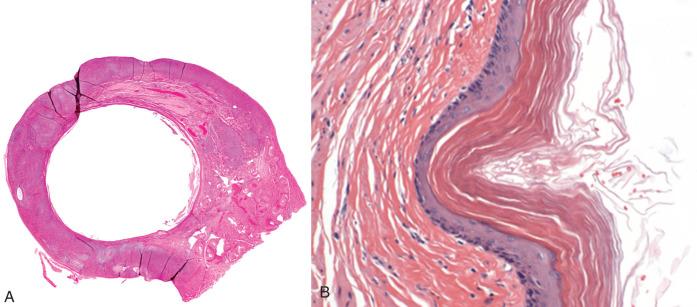
Mature teratoma
Mature cystic teratoma
The management of a mature teratoma is influenced by the risk of malignancy—a function of the age of the patient—and the desire to minimize surgical trauma. Typically, cystectomy is performed to preserve ovarian function; however, follow-up is necessary to exclude recurrence, which occurs in 4% to 5% of cases and, because the latter is typically asymptomatic, periodic ultrasound examination is recommended. Multiple mature teratomas in a single ovary and bilateral teratomas may have a greater risk for recurrence. Laparoscopy is acceptable, provided that strict guidelines are followed that pertain to any ovarian mass. For younger patients, preoperative serologic studies to exclude a malignant germ cell tumor are indicated, and every patient must be made aware of the small risk of malignancy, which would necessitate a second surgical procedure.
The monodermal variants of mature teratoma include those containing thyroid tissue (e.g., struma ovarii, strumal carcinoid, malignant struma), carcinoid tumors, and other rare proliferations. The great majority of monodermal teratomas are strumas, which correspond to about 2% of all ovarian teratomas and less than 1% of all ovarian neoplasms. Somatic-type malignancy is a rare occurrence in ovarian mature teratoma and occurs in approximately 1% to 2% of tumors. The great majority of these tumors are epithelial and, of these, approximately 65% are squamous cell carcinomas. All tumors in this category are composed of adult-type somatic tissues and arise from proliferation of a teratomatous cell, as has been shown by some molecular studies.
Struma ovarii are monodermal mature teratomas exclusively composed of thyroid tissue or mature teratomas containing a significant representation of thyroid component that can be benign or malignant. To be classified as struma ovarii, the tumor has to meet at least one of the following criteria ( Box 26.2 ) :
Tumor composed exclusively of thyroid tissue
Mature teratoma with greater than 50% thyroid tissue, grossly visible or not
Mature teratoma with less than 50% thyroid tissue, grossly visible
Any mature teratoma with malignant thyroid tissue, independent of extent or gross appearance, specifically termed malignant struma ovarii
Tumor composed exclusively of benign thyroid tissue
Mature teratoma with >50% benign thyroid tissue, grossly visible or not
Mature teratoma with <50% benign thyroid tissue that is grossly visible
Any mature teratoma with malignant thyroid tissue, independent of extent or gross appearance
Subtypes:
Histologically malignant struma ovarii resembling papillary thyroid carcinoma
Proliferative (malignant) struma ovarii
Highly differentiated follicular carcinoma of ovarian derivation
Histologically malignant struma ovarii with high-grade features
The great majority of struma ovarii are composed of conventional benign thyroid tissue. Malignant struma ovarii usually show histologic features of thyroid follicular adenoma or papillary carcinoma and are discussed in the next section.
Approximately 7% of mature teratomas have microscopic thyroid tissue; but less than 2% meet the criteria for struma ovarii. Although struma is the most common of ovarian monodermal teratomas, in two large cohorts of patients with ovarian tumors from single institutions, only 34 of 10,442 (0.3%) and 16 of 1501 (1%) were struma ovarii. Of all struma ovarii, approximately 60% are entirely composed of thyroid and 40% are associated with other teratomatous components.
Tumors other than mature teratomas that have been seen in association with struma ovarii are Brenner tumor, fibrothecoma, and serous and mucinous cystadenoma. These components may be considered as independent epithelial tumors (somatic origin) or as part of the teratoma spectrum (germ cell origin).
Struma ovarii occurs most frequently in the fifth decade, with a median age of about 45 years for benign struma. Extragonadal cases of struma have been reported in the fallopian tube (struma salpingii), uterine cervix (struma uteri), and vaginal wall, and even in the testis.
Unlike most classic mature teratomas, most struma ovarii are not diagnosed preoperatively, inasmuch as the ultrasound appearance is not as specific, depicting it as a heterogeneous solid or cystic mass. Less than 15% of struma ovarii are recognized as such by imaging studies; the remaining are mistaken for other benign processes, such as mature teratomas without struma, endometriomas, or other benign cysts. Almost 30% of strumas in general can show features that may be misleading for malignancy. Clinicians are advised to proceed cautiously if a suspected teratoma contains a complex ultrasonographic picture because a benign struma may be the cause.
At least 40% of strumas are asymptomatic and are recognized as an incidental finding; symptomatic patients most often report lower abdominal pain. Approximately 8% have abnormal vaginal bleeding, which is likely to result from luteinization of surrounding ovarian stromal cells that is sometimes prominent in these neoplasms. Infertility has been rarely reported.
Clinical evidence of hyperthyroidism in benign struma is uncommon. Two case series with 34 and 16 patients have reported no patients with symptoms of hyperthyroidism. Thyroid hormone serology is typically not performed because patients do not report suspicious symptoms. Thyrotoxicosis (Graves' disease) is rare and occurs in benign and malignant struma ovarii.
Patients rarely develop hypothyroidism. Five cases of mature teratoma (with thyroid tissue not qualifying for struma ovarii) and five cases of struma ovarii with features of Hashimoto thyroiditis have been reported in patients who developed hypothyroidism. Most cases were categorized as ectopic Hashimoto thyroiditis due to the association of ectopic thyroid tissue with lymphocytic infiltration and, in three cases where this was lacking, by hypothyroidism, with positive antibodies as measured by blood tests. A single case of hyperemesis gravidarum has been reported in a patient with struma ovarii.
Mildly elevated serum cancer antigen 125 (CA-125) levels are found in up to 30% of patients with struma ovarii in general. However, in the presence of ascites, this level may be in the hundreds to low thousands. This measurement in not useful in the distinction between benign and malignant struma.
The triad of pleural effusion, ascites, and ovarian fibroma defines Meigs syndrome. The same presentation when encountered with other benign ovarian tumors is typically referred to as pseudo-Meigs syndrome. The development of this syndrome has been reported in association with at least 20 patients with struma ovarii. They tended to have significant moderate to marked elevation of serum CA-125 levels. A review of 11 patients has revealed that most are postmenopausal (73%). The average reported size of the tumor was 10 cm, with 9% rate bilaterally, and right-sided predominance. Therefore, strumas associated with pseudo-Meigs syndrome are slightly larger (10 cm vs. 9 cm) and more often bilateral (9% vs. 1%) than strumas in general. One-third of patients had hypothyroidism or hyperthyroidism, a rate also remarkably higher than that of conventional strumas (36% vs. 5%). Interestingly, an additional 10 cases of struma ovarii, with high-volume ascites without hydrothorax (and therefore not qualifying for pseudo-Meigs syndrome), have been reported and had similar features, including frequent postmenopausal status and large size. Unlike regular strumas, patients in both scenarios are almost always symptomatic, and the tumor is almost always suspected to be a malignant tumor preoperatively.
Like all specialized patterns of differentiation, these tumors are classically unilateral; less than 1% of struma ovarii are reported to be bilateral. The frequency of a contralateral mature teratoma is approximately 7%, slightly lower than teratomas in general. The mean size is 9 cm.
On gross examination, if visible, the thyroid component has the characteristic appearance of normal thyroid. It appears as greenish brown, fleshy slightly gelatinous tissue ( Fig. 26.10 ).
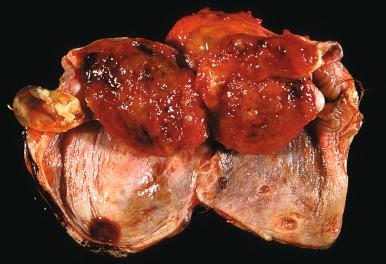
Most struma ovarii are solid or solid-cystic, whether or not associated with a mature teratoma. A small proportion of tumors, approximately 5%, may appear as serous cystadenomas that form a thin-walled multiloculated cyst with serous fluid; these can be referred to as cystic struma ovarii. The material contained in these cysts may be green or brown-tinged, which provides a clue to the diagnosis.
The diagnosis of struma ovarii is usually straightforward—that is, macro- and microfollicles contain colloid, closely resembling the thyroid gland ( Fig. 26.11 ). Variations in histologic appearance include inconspicuous pseudotubular and cordlike arrangements and solid patterns lacking colloid ( Fig. 26.12 ). Most cases have scant stroma but in some cases the presence of fibromatous stroma and less conspicuous follicle formation may mimic an adenofibroma or Brenner tumor ( Fig. 26.13 ). Some are associated with abundant edematous stroma. Ovarian stromal luteinization can be seen.
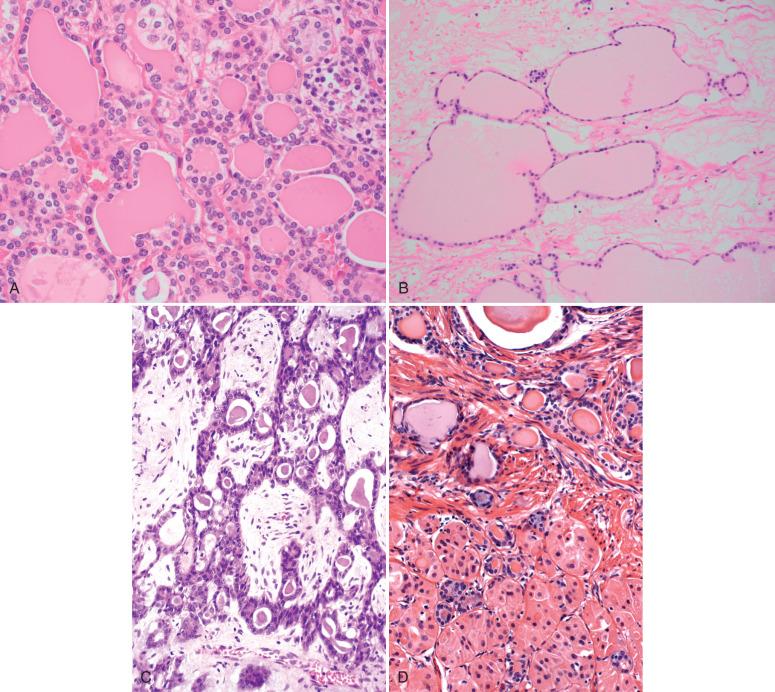
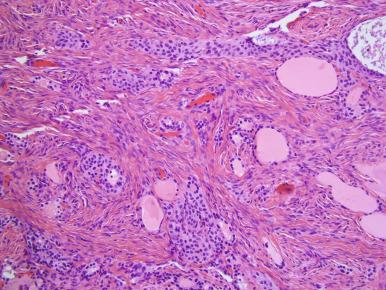
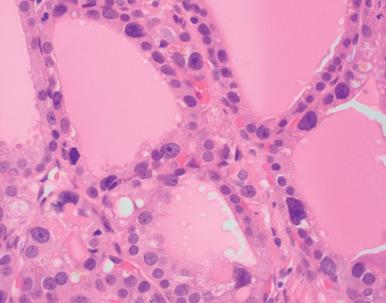
Follicular cells can be flat, cuboidal, or columnar. The cytoplasm is usually pale or eosinophilic. Some cases show abundant eosinophilic cytoplasm, characteristic of Hurthle cells (see Fig. 26.12 ). Clear cell changes can be seen but a predominant clear cell pattern is uncommon. Nuclei are uniform, round to oval, and show evenly distributed chromatin and smooth nuclear membranes. Nucleoli are small. Endocrine-type atypia may be focally present in some cases (see Fig. 26.13 ), characterized primarily by nuclear enlargement, and is not indicative of malignancy ( Fig. 26.14 ). The typical struma ovarii contains rare to a few mitoses.
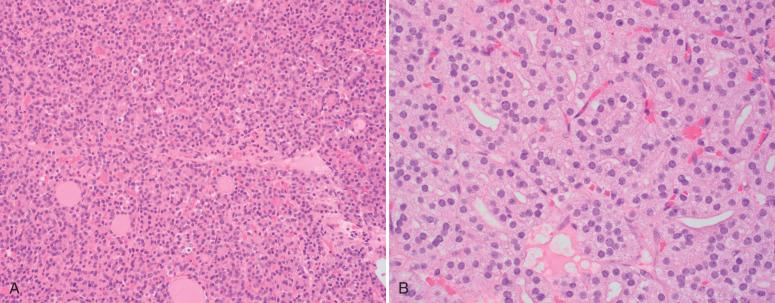
Benign struma should not have any architectural or cytologic features of papillary thyroid carcinoma or proliferative changes that would resemble follicular adenoma in the thyroid gland, which would be suggestive of malignant struma.
Struma cells are positive for thyroid transcription factor 1 (TTF-1) and thyroglobulin; the former has great sensitivity and specificity and is sufficient to confirm the diagnosis. Lung tissue is almost never seen in mature teratomas, and the only other lesion that could be positive for TTF-1 in the ovary is metastasis from a lung tumor, excluding rare cases of primary ovarian carcinomas that have shown TTF-1 staining. If cells showing positive nuclear staining for TTF-1 are also positive for neuroendocrine markers, such as chromogranin and synaptophysin, the best interpretation would be strumal carcinoid (discussed later in the chapter).
The differential diagnosis of struma ovarii includes carcinoid, sex cord–stromal tumors, epithelial tumors, and metastasis, particularly if colloid and typical follicular arrangements are inconspicuous, and the epithelial cells are arranged in tubules, cords, and microfollicles devoid of colloid. Another pitfall is struma ovarii with a predominance of clear cells or cells with abundant eosinophilic cytoplasm. The key to diagnosis is a high index of suspicion, particularly if other components of teratoma are present. In difficult cases, areas with a more characteristic appearance of thyroid tissue are present in most cases. Immunostaining for TTF-1 and thyroglobulin is positive in struma ovarii and strumal carcinoid and negative in other differentials, greatly facilitating the diagnosis. Below is a list of tumors that may have a histologic appearance similar to struma ovarii.
These can also grow in acini, trabeculae, and tubules.They are often associated with a mature teratoma, ifthe carcinoid tumor is an ovarian primary. Nuclear features of neuroendocrine tumor such as so-called salt andpepper chromatin may be helpful but can overlap with granular chromatin seen in follicular cells. Primary carcinoidtumors in the ovary are positive for neuroendocrine markers and negative for TTF-1. Although metastatic intestinal or pancreatic carcinoids to the ovary arepositive for neuroendocrine markers and negative for TTF-1, carcinoids of pulmonary origin can be positive for both.
Intimally admixed struma and carcinoid may be very difficult to distinguish by histomorphology. It is best to use a panel of immunostains. Areas positive for TTF-1 and negative for neuroendocrine markers are classified as struma, whereas areas negative for TTF-1 and positive for neuroendocrine markers are classified as carcinoid. The combination of the two in the same ovarian tumor is diagnostic for strumal carcinoid. Cells showing simultaneous positive nuclear staining for TTF-1 and positive cytoplasmic staining for neuroendocrine markers also support a diagnosis of strumal carcinoid. One caveat is carcinoid tumor of pulmonary origin metastatic to the ovary, many of which show positivity for both markers.
Architectural features of some ovarian sex cord–stromal tumors may be mimics of solid and cellular areas of struma ovarii, particularly Sertoli cell tumor, steroid cell tumor, and granulosa cell tumor. Follicles of struma may simulate Call-Exner bodies of granulosa cell tumor. The presence of other teratomatous components would render a diagnosis of struma ovarii much more probable. Immunostains are definitive in all these differentials because sex cord–stromal tumors are positive for inhibin, calretinin, and SF1 and negative for TTF-1.
Two great mimickers are endometrioid adenocarcinoma and clear cell carcinoma. These tumors, like struma, would be positive for PAX8; however, they are negative for TTF-1, with rare exceptions.
Both tumors can show a nested growth pattern and cells with abundant eosinophilic cytoplasm. Melanoma markers such as S-100, HMB-45, and Melan A can be used in suspected cases of melanoma. For pituitary-like adenomas, the staining pattern is variable, depending on the constituting cells, but negative TTF-1 would be helpful in excluding struma ovarii.
Consideration could be given to metastatic renal cell carcinoma, clear cell type, and hepatocellular carcinoma, all of which can be worked up with immunostains—PAX2, PAX8, CD10, and RCC for the former and arginase-1, glypican 3, and Hep Par 1 for the latter.
In every case of struma ovarii, malignant struma should be excluded. Worrisome histologic patterns that should be carefully examined for the possibility of malignancy include architectural or cytologic features of papillary thyroid carcinoma and proliferative changes that would resemble follicular adenoma in the thyroid gland. In addition, infiltration of the ovarian serosa with tumor on the surface of the ovary, or any form of extraovarian spread, is also indicative of malignant struma, regardless of the histology and even in the context of bland usual thyroid tissue appearance. Diagnostic criteria for malignant struma are discussed below (see “ Malignant Struma Ovarii ”).
Monodermal teratomas composed exclusively of benign thyroid tissue—struma ovarii
Mature teratomas containing thyroid tissue that meet criteria for struma ovarii—mature teratoma with struma ovarii or struma ovarii arising in association with mature teratoma
Mature teratomas containing thyroid tissue but that do not meet criteria for struma ovarii—mature teratoma with focal thyroid differentiation
Any struma ovarii that is entirely cystic simulating serous cystadenoma—cystic struma ovarii
Struma ovarii is a benign neoplasm in the great majority of cases and by definition does not spread beyond the ovary. If it does, it must be classified as malignant struma, even when it has an innocuous, non-neoplastic appearance. Proliferative strumas are also regarded as potentially malignant, independent of the presence or absence of extraovarian spread. High-risk features in struma ovarii that could correlate with aggressive behavior are large size, abundant adhesions, and ovarian serosal defects.
Struma ovarii associated with high-volume ascites, with or without pseudo-Meigs syndrome, achieve complete remission of ascites, hydrothorax, and elevated CA-125 levels following surgical resection of the ovarian mass. No recurrences have been reported and therefore it appears that associated pseudo-Meigs syndrome does not place struma ovarii in a high-risk category for malignancy. Of note, few cases of pseudo-Meigs syndrome have been associated with malignant struma ovarii.
The concept of malignant struma ovarii is not short of controversy and may as well be considered enigmatic. The matter is not as simple as identifying malignant-looking thyroid tissue in an ovarian neoplasm; on the contrary, the challenge is to define malignancy when malignant clinical behavior does not correlate with the histologic appearance. This difficulty is faced with many endocrine neoplasms; the most classic example is pheochromocytoma. In ovarian pathology, a similar scenario is encountered with a tumor that although not traditionally classified as endocrine, has the capacity of hormonal production—namely, granulosa cell tumor, which has an uneventful clinical course in about 90% of patients. No histologic or molecular parameter has been able to predict definitely who will be in the 10% of cases that will recur after numerous investigations. This may also be the case for (malignant) struma ovarii, a much more infrequent tumor than the aforementioned examples, which as a result poses more difficulty in drawing conclusions. Another common feature shared by these neoplasms is the slow growth and indolent clinical course, even following recurrences and metastases. Currently, malignant struma ovarii is regarded as a neoplasm of low malignant potential, with the only exception being tumors with high-grade features, as discussed later.
The literature has traditionally lumped struma ovarii with malignant histology, independent of behavior, and struma with malignant behavior, independent of histology, under the umbrella of malignant struma ovarii. This seems to be a reasonable approach at our current state of understanding. On the basis of this principle, and drawing a parallel with the thyroid gland, malignant struma may be categorized in the following way (see Box 26.2 ):
Histologically malignant struma ovarii, resembling papillary thyroid carcinoma
Proliferative (malignant) struma ovarii, resembling follicular adenoma
Highly differentiated follicular carcinoma of ovarian derivation, resembling non-neoplastic thyroid tissue but with spread to extragonadal locations
Histologically malignant struma ovarii with high-grade features
Diagnostic criteria and biologic behavior for each of these categories will be discussed. Most of the data available for malignant struma ovarii have been presented as case reports or case series from consultation files, some of which have included a review of cases previously published by other groups. The advantage of these studies is that long-term follow-up was available for most patients, an important factor in the evaluation of these slow-growing neoplasms.
In case series from single institutions, without consultation biases, the rate of malignant struma among struma ovarii has been reported as 5 of 34 (14.7%), 11 of 118 (9%), and 2 of 16 (12%). Considering that only 1% of all ovarian neoplasms are struma ovarii, the incidence of malignant struma is very low, estimated to be less than 1/10,000,000 females per year in the United States. In one study, only five cases (0.05%) of malignant struma ovarii were identified in a cohort of 10,442 ovarian tumors from a single institution.
The median age for patients with malignant struma ovarii does not seem to differ significantly from patients with benign struma, reported to be 41 years for the former and 45 years for the latter.
Struma ovarii is defined as clinically malignant if it meets one of the following criteria, regardless of whether it is histologically benign or malignant :
Thyroid tissue infiltrating ovarian serosa with tumor on the ovarian surface
Extragonadal spread at presentation
Recurrence after initial surgery
Almost 50% of patients with malignant struma present with abdominal swelling, pain, or a mass. In about 40% of cases, malignant struma is an incidental finding. One-third of the patients may have vague signs and symptoms of hyperthyroidism, which is typically not severe enough to prompt clinical and laboratorial investigation prior to tumor diagnosis. Patients with clinical hyperthyroidism have a tendency to have large tumors that are clinically malignant in the absence of malignant histology. Thyrotoxicosis (Graves' disease) is rare and occurs in benign and malignant struma ovarii. Of all patients 7% report abnormal vaginal bleeding. High-volume ascites or hydrothorax are seen in less than 10% and 5% of patients, respectively. Malignant struma presenting with metastatic bone disease and an occult primary has been reported in two case reports and, although very rare, an ovarian origin should be considered when metastatic thyroid carcinoma is detected in the absence of a thyroid tumor.
The gross appearance of the malignant struma will vary depending on the histologic subtype and extent of the malignant component. Many are undetectable by gross examination showing the characteristic appearance of normal thyroid, seen as a greenish brown, fleshy, slightly gelatinous tissue, with or without associated mature teratoma (see Fig. 26.10 ). Large areas of papillary thyroid-type carcinoma may appear more firm and fibrotic.
Most areas of malignant struma are solid; the average diameter is 12 cm, including any associated teratoma ( Fig. 26.15 ). Of these malignant strumas, 7% are bilateral and an additional 13% have a contralateral teratoma without struma. Almost 50% of malignant strumas are pure and 50% are associated with other teratomatous components.
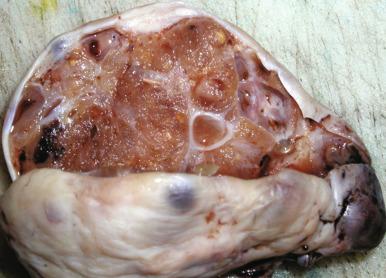
Any struma ovarii infiltrating the ovarian serosa and involving the ovarian surface is considered malignant; therefore, the ovarian surface should be carefully inked and well sampled in any suspected case of struma ovarii encountered during the gross examination. Surface ovarian adhesions have also been associated with an increased risk for extragonadal spread and recurrence in struma ovarii. They should be documented and sampled, whenever present.
Most malignant struma ovarii have histopathologic features of papillary thyroid carcinoma or follicular adenoma; it is not possible to predict which of these will have malignant behavior. Very rarely, struma ovarii with the appearance of normal thyroid tissue spreads to extragonadal locations and is then considered malignant struma. Finally, few cases with histopathologic features of thyroid carcinoma contain high-grade foci; this is the only category that is known consistently to behave aggressively.
This displays typical nuclear features of papillary thyroid carcinoma, including nuclear enlargement, chromatin clearing (referred to as Orphan Annie eyes), nuclear grooves, and nuclear pseudoinclusions ( Figs. 26.16 to 26.18 ). The diagnosis is straightforward when the tumor has a papillary architecture characteristic of the classic variant (see Fig. 26.16A ). Cases with features of a follicular variant of papillary thyroid carcinoma are also encountered and, when considered, should be diagnosed with strict cytologic criteria, which are the same as those applied in thyroid pathology, involving at least 50% of tumor cells (see Figs. 26.17 and 26.18 ). Most cases in this category do not spread beyond the ovary and do not necessarily equate to malignant behavior.
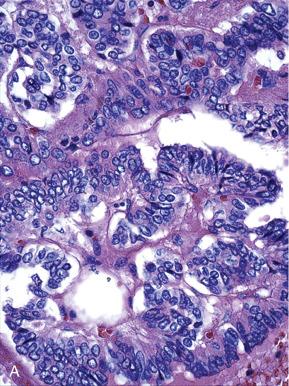
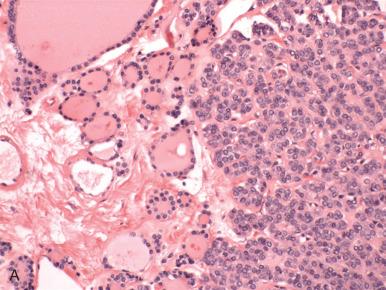
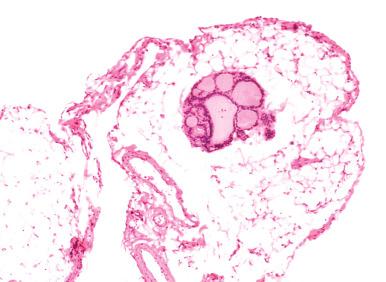
This resembles follicular microadenoma and macroadenoma in the thyroid gland but without a capsule. The ovary does not have a capsule, and these tumors typically are not encapsulated; therefore, the presence of a capsule or capsular invasion is not a diagnostic criterionto define a struma as proliferative (meaning follicular adenoma) or malignant (as in follicular carcinoma). Areas of struma ovarii qualifying as proliferative should be densely cellular, with back-to-back follicles, trabeculae, or solid growth but without nuclear atypia that could be classified as papillary thyroid carcinoma or poorly differentiated or anaplastic thyroid carcinoma. Interestingly, the macrofollicular pattern is more often seen in clinically malignant tumors than the microfollicular or trabecular patterns. Vascular invasion is almost never seen. It has been defined as large tumor aggregates in multiple vessels or adhering to the vessel wall, not including capillary vascular invasion, which is deemed to represent artifact in most cases. If present, it may be reported as histologic evidence of malignant struma (equating to follicular carcinoma); however, its absence by no means indicates that a proliferative struma is necessarily benign. Extraovarian spread is not required to place an ovarian struma in this category. These tumors have a low but definite possibility of malignant behavior.
Highly differentiated follicular carcinoma of ovarian derivation (HDFCO) are struma ovarii resembling non-neoplastic thyroid tissue that spreads to extragonadal locations, with an innocuous appearance, similar to non-neoplastic eutopic thyroid tissue in ovarian and extraovarian sites ( Fig. 26.19 ). The latter, by definition, must be documented concurrently or following the initial primary as a fundamental criterion for this diagnosis.

These are tumors that in the thyroid gland would be classified as poorly differentiated carcinoma (see Fig. 26.16B ) or anaplastic carcinoma. They are characterized by solid growth, increased cytologic atypia, and mitoses. Coagulative necrosis may be present. High-grade features may be focal or diffuse. In one reported case, foci of anaplastic carcinoma were only identified in peritoneal tumors and not in the primary ovarian mass. Only tumors with high-grade cytologic features have a high predictive value for malignant clinical behavior.
Luteinized stromal cells are found in 17% of cases of malignant struma ovarii, more often in association with proliferative strumas.
Malignant struma ovarii stain positive for thyroglobulin and TTF-1, even when poorly differentiated. Malignant struma ovarii with histologic features of papillary thyroid carcinoma are usually positive for CK19, galectin-3, and HMBE-1, as in the thyroid gland (see Figs. 26.16 to 26.18 ). Likewise, malignant cases may harbor mutations in BRAF , HRAS, and KRAS that are not detected in benign struma. Malignant struma with the histologic appearance of a follicular variant of papillary thyroid carcinoma tend to show RET gene rearrangements. Based on these findings, the development of carcinoma in struma ovary appears to share similar pathogenic mechanisms with the thyroid gland, because most mutations have been shown to occur in both locations, with a few exceptions.
The main role of the pathologist is to distinguish benign and malignant struma ovarii by recognizing all the histologic patterns that form the spectrum of malignancy in stroma ovarii (as discussed earlier). Otherwise, the differential diagnoses will depend on the histologic appearance of the struma in question. In all the scenarios outlined below, immunostaining for TTF-1 is very helpful because it is positive in any struma ovarii, benign or malignant, and is negative in all other differentials, with the exception of strumal carcinoid and metastatic lung carcinoid.
Because the ovary is a common site for metastases, it is important to search for areas with a more characteristic appearance of thyroid tissue or other teratomatous components to characterize the tumor as primary in the ovary. Of interest, metastases of papillary thyroid carcinoma to the ovary have been rarely reported, and synchronous papillary carcinoma in the thyroid gland and struma ovarii have also been reported. Differentials include those that resemble the following.
The diagnosis is usually straightforward because the tumor has conspicuous cytologic features of papillary thyroid carcinoma in a papillary architecture. The differential diagnoses would include other papillary carcinomas, such as ovarian serous carcinoma and ovarian clear cell carcinoma; these usually show other growth patterns in addition to papillary architecture. Nuclear grade is higher, and mitoses are more numerous. Both are positive for PAX8 and negative for TTF-1.
Metastatic tumors with a papillary growth pattern could originate from various locations, such as the breast, kidney, and lung. Immunostains should be used according to the clinical scenario.
Differential diagnoses are similar to the ones discussed for benign struma and include tumors with a compact growth of epithelioid cells arranged in tubules, cords, and microfollicles or with a predominance of cells with abundant clear or eosinophilic cytoplasm. These are comprised of primary and metastatic carcinoid tumors, strumal carcinoid, granulosa cell tumor, Sertoli cell tumor, adenocarcinomas of müllerian origin, particularly endometrioid grade 1 and clear cell carcinoma, melanomas, and pituitary adenomas arising in mature teratomas, and metastatic malignancies, mainly metastatic renal cell clear cell carcinoma and hepatocellular carcinoma
HDFCOs include metastatic tumors to the peritoneum, bone, or liver that can have the appearance of non-neoplastic thyroid, but these do not not occur often. Consideration could be given to metastatic tumors that can grow in microfollicular patterns with a deceivingly bland cytologic appearance, such as granulosa cell tumor and carcinoid tumors.
These are comprised of numerous poorly differentiated and anaplastic carcinomas of various origins. It is particularly critical to identify areas of better-differentiated thyroid tissue and teratomatous components. A high level of suspicion is important because this would prompt immunostaining for TTF-1, which is diagnostic concerning all differentials, with the exception of metastatic carcinoma of lung origin.
Malignant struma resembling papillary thyroid carcinoma
Malignant struma ovarii (classical papillary thyroid-type carcinoma). See comment.
Malignant struma ovarii (follicular variant of papillary thyroid-type carcinoma). See comment.
Proliferative struma ovarii
Comment: These neoplasms have a low malignant potential. The biologic behavior cannot be predicted on the basis of histologic examination in the absence of extraovarian disease. Prolonged follow-up is advised as recurrences may occur years after the initial diagnosis.
Highly differentiated follicular carcinoma of ovarian derivation:
Malignant struma ovarii consistent with highly differentiated follicular carcinoma of ovarian derivation.
Comment: The diagnosis was based on the presence of ovarian surface involvement and/or extraovarian disease. These neoplasms tend to have an indolent clinical course.
Malignant struma with high-grade features
Malignant struma ovarii with high-grade features (poorly differentiated thyroid-type carcinoma). See comment.
Malignant struma ovarii with high-grade features (anaplastic thyroid-type carcinoma). See comment.
Comment: These neoplasms tend to behave aggressively similar to the counterparts in the thyroid gland.
In all these, it is important to include the following:
Size of malignant struma component
Presence or absence of benign struma and other teratomatous elements
Percentage of malignant struma component in comparison with benign struma, if present
Presence or absence of ovarian surface involvement or surface adhesions
Presence or absence of lymphovascular invasion
Most cases with malignant features by histology do not progress to extraovarian disease, recurrence, or metastasis. a
a References .
Likewise, proliferative strumas, and even strumas with non-neoplastic thyroid histology, may present with extraovarian disease or have recurrences. b
b References .
No histologic features are predictive of biologic behavior. The only exceptions are struma ovarii with high-grade features, which are exceedingly rare and have been shown consistently to behave in an aggressive fashion.
The size of the struma component is of prognostic significance, regardless of histology. Strumas measuring less than 4 cm do not seem to recur; clinically malignant strumas are larger and have a greater percentage of malignant struma than those that are clinically benign. Surface adhesions or rents are associated with extraovarian spread and recurrences. More than 1 L of ascites has been shown to be an adverse prognostic indicator in one cohort. Remarkably, about 30 case reports have described benign struma ovarii presenting with large-volume ascites, with or without pseudo-Meigs syndrome, and not a single documented case of extraovarian disease or recurrence, which brings into question the significance of large-volume ascites as an adverse sign. Rare reports of pseudo-Meigs syndrome have been associated with malignant struma ovarii.
Approximately 18% of malignant strumas in general have ovarian surface involvement or extraovarian spread at diagnosis, usually in the pelvic and abdominal peritoneum. Distant metastases are rare and tend to involve bone, particularly the spine. Of clinically malignant tumors, 31% were histologically malignant, 65% were histologically proliferative, and 4% were histologically benign, according to the most recent and largest case series. The probability of a malignant clinical course was 30% overall for any histology in another case series by a different group. Overall 10- and 25-year survivals are 89% and 84%, respectively. The initial stage does not affect overall survival. Recurrences tend to be late and average 4 years after initial diagnosis; survival rates are around 85%, even for recurrent tumors. Death also occurs late, with a mean interval from the initial diagnosis of 20 years for stage IA tumors and 10 years for higher stage tumors.
The main exception to these observations are struma ovarii with high-grade features, which are exceedingly rare and have been shown to behave frequently in a malignant fashion. Extraovarian spread is typically present at the time of diagnosis. Death usually occurs months to a few years after the initial diagnosis.
Almost 90% of cases of HDFCO have peritoneal spread at the time of initial diagnosis. About 20% of patients develop distant metastases, usually to liver and bone, and rarely o the lung. Even in the presence of peritoneal and distant spread, the prognosis is excellent, with no documented deaths.
As noted earlier, along with struma ovarii resembling papillary thyroid carcinoma, proliferative strumas have a similarly low but definite possibility of recurrence and therefore would be best regarded as being of low malignant potential. In the future, we may consider classifying struma ovarii akin to epithelial ovarian tumors in three categories—benign, borderline or of low malignant potential (LMP), and malignant. Judging from the evidence provided by recent publications, only malignant struma ovarii with high-grade features have definite clinical characteristics of a malignant process. Therefore, even struma ovarii with histologic features of papillary thyroid carcinoma may be placed in the LMP category in case this classification scheme is ever adopted.
In the past, the presence of small foci of benign-looking thyroid tissue in the peritoneum of patients with struma ovarii was termed strumosis (see Fig. 26.19 ). However, studies have shown that these patients can progress to have multiple recurrences; therefore, this term is to be avoided.
There is no standard management scheme for malignant struma ovarii. It appears that good local control is achieved by surgical removal of the primary ovarian tumor and of pelvic and peritoneal tumor deposits, if present. Late recurrences require long-term follow-up, of at least a 10-year duration. Stage IA tumors may benefit from follow-up with iodine-131 ( 131 I) body-wide uptake scans. Radioactive iodine therapy may be considered in higher stage tumors, in which case total thyroidectomy may be considered as an adjunct for treatment. Patients with malignant struma ovarii with high-grade features may benefit from chemotherapy and radioactive iodine therapy, independent of stage. Radiotherapy has been used successfully for bone metastasis.
In the ovary, carcinoid tumors are well-differentiated neuroendocrine neoplasms that are believed to arise in association with or through the same pathway as mature teratomas. In most cases, other teratomatous components are identified. The rest, in the absence of other teratomatous components, are considered monodermal teratomas.
Ovarian carcinoid tumors are rare and correspond to less than 2% of carcinoid tumors in general. Histologically, most resemble well-differentiated neuroendocrine tumors of the gastrointestinal tract and are classified as follows ( Table 26.2 ):
Insular carcinoid
Trabecular carcinoid
Goblet cell (mucinous) carcinoid
Strumal carcinoid
| Parameter | Type of Carcinoid | ||||
|---|---|---|---|---|---|
| Insular | Trabecular | Strumal | Goblet Cell | Metastatic | |
| Gastrointestinal counterpart | Midgut | Foregut and hindgut | — | Appendix | Origin in midgut |
| Most affected age group | Perimenopausal, postmenopausal | Perimenopausal, postmenopausal | Postmenopausal | Reproductive age | Perimenopausal, postmenopausal |
| Carcinoid syndrome | Common | Rare | Rare | Rare | Common |
| PPY-related constipation | No | Yes | Yes | No | No |
| Laterality | Unilateral | Unilateral | Unilateral | Unilateral | Bilateral |
| Associated teratoma | Common | Common | Common | Common | Never |
| Gross appearance | Single nodule ± cystic areas | Single nodule ± cystic areas |
Single nodule ± cystic areas |
Single nodule ± cystic areas |
Multinodular |
| Growth pattern | Insular | Trabecular | Often trabecular + follicular | Acinar and glandular | Insular |
| CDX2 immunostain | Positive | Negative | Negative | Positive | Positive |
| Prognosis | Favorable | Favorable | Favorable | Favorable | Poor |
Of all four, only strumal carcinoid does not have a gastrointestinal counterpart and is exclusive of teratomatous neoplasms. It should be noted that there are mixed primary ovarian carcinoids, such as insular and trabecular or strumal and goblet cell. Ovarian metastases of carcinoid tumors are discussed later in this chapter.
The average age at diagnosis for all primary ovarian carcinoid tumors combined is about 50 years old. Primary ovarian carcinoid tumors are almost invariably unilateral, and this feature aids in the distinction from metastatic carcinoid tumors, which are typically bilateral. Most pure ovarian carcinoids measure more than 5 cm and are larger than carcinoids identified as a component of mature teratoma, which are usually less than 5 cm. Carcinoid syndrome is also more common in pure carcinoids (23% vs. 14% of cases) and occurs at a significantly higher rate in patients with insular carcinoids (almost 40%) compared to trabecular (7.8%) and strumal carcinoids (3.2%). Carcinoid syndrome should resolve after the removal of a primary carcinoid tumor confined to the ovary.
Carcinoids are low-grade, slow-growing tumors. Metastases occur in 13% of primary ovarian carcinoids in general and are usually observed in pure ovarian carcinoids (22% of patients). Only about 5% of carcinoid tumors associated with mature teratomas metastasize. Metastases usually involve the liver and peritoneum and, infrequently, lymph nodes. Overall survival is almost 90% for all primary ovarian carcinoids combined and is lower for pure ovarian carcinoids (84%) compared to teratoma-associated carcinoids (93.7%)
Insular carcinoids resemble midgut carcinoids and are the most common pattern in the ovary, corresponding to approximately 50% of primary ovarian carcinoid tumors (see Table 26.2 ). Most patients are postmenopausal or perimenopausal. At least one-third to two-fifths are associated with carcinoid syndrome, which occurs more frequently in tumors larger than 7 cm and in patients older than 50 years. Unlike intestinal carcinoids, liver metastases are not a requirement for the development of carcinoid syndrome. Insular carcinoids are not traditionally associated with peptide YY (PPY) production and constipation. However, one case has been described for which this manifestation was associated with a mixed insular and trabecular ovarian carcinoid.
Tumors are almost invariably unilateral. They present as firm, solid, homogeneous, gray to yellow masses, often in association with mature teratoma or mucinous tumors, that can also be found in the contralateral ovary ( Fig. 26.20 ).
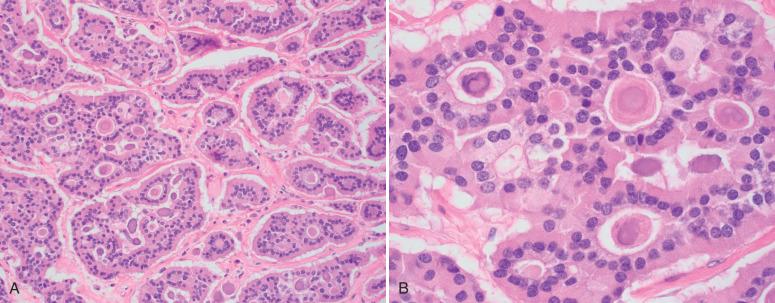
Histologically, two distinguishing features characterize insular carcinoids: architecture and cytology. They are composed of large islands, variably sized nests, and small acini or glands set in a fibrous stroma ( Fig. 26.21A ). Islands and nests tend to show an uneven cribriform appearance resulting from the presence of acinar lumens predominately located toward the periphery. Simple tubular glands tend to be arranged in garland-like patterns or small groups, with sharply defined central lumina and, frequently, a surrounding retraction artifact.
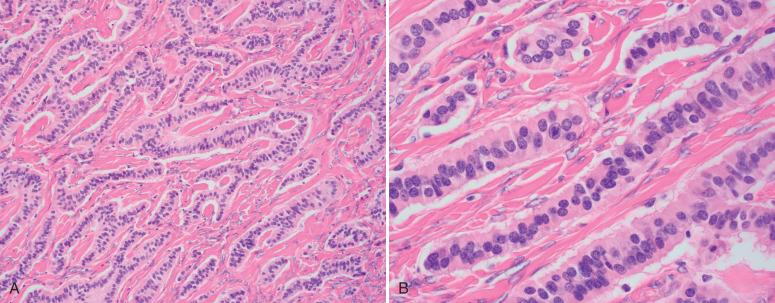
The cells are polygonal and uniform and have round monotonous nuclei with so-called salt and pepper chromatin (see Fig. 26.21B ). Mitotic activity is low. The cytoplasm is ample, lightly eosinophilic, and often contains red to brown argentaffin granules polarized toward the base.
Carcinoid tumors are positive for pankeratin and neuroendocrine markers. Chromogranin and synaptophysin are more specific and are preferred to CD56. Primary ovarian insular carcinoid tumors are negative for CK7, CK20, and TTF-1 and often positive for CDX2.
The differential diagnosis of insular carcinoid comprises tumors that form nests composed of bland-looking cells. Because of fixation artifacts, the pathologist may not always appreciate the stippled nuclear features of insular carcinoid (see Fig. 26.21C ). Brenner tumor, endometrioid adenocarcinoma, sex cord–stromal tumors, Sertoli cell or granulosa cell tumor, and metastatic adenocarcinomas, particularly gastrointestinal, can look similar to insular carcinoid tumors. Immunostains are helpful because sex cord–stromal tumors are positive for inhibin, calretinin, and SF1, endometrioid adenocarcinomas are positive for PAX8, and Brenner tumors are positive for urothelial markers such as p63, GATA3, and S-100P. The presence of other teratomatous components would render a diagnosis of primary ovarian carcinoid tumor more probable.
If the tumor is bilateral, multilobular, or unaccompanied by a mature teratoma, a metastatic midgut carcinoid must always be considered. Immunostains are not helpful in this distinction.
The outcome of insular carcinoids is favorable. Recurrences and metastases are rare.
Become a Clinical Tree membership for Full access and enjoy Unlimited articles
If you are a member. Log in here